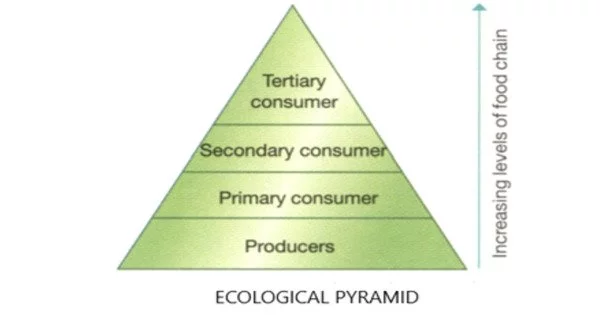An ecological pyramid is a graphical representation of an ecosystem’s trophic structure (feeding interactions) and energy flow. It is a graphical depiction designed to show the biomass or bioproductivity at each trophic level in an ecosystem. It is also known as the trophic pyramid, energy pyramid, or even food pyramid. It depicts the distribution of energy, biomass, or organism numbers at each trophic level of a food chain or food web.
A biomass pyramid displays how much biomass (the quantity of living or organic matter contained in an organism) is present in the organisms, whereas an energy pyramid shows how much energy is kept in the form of new biomass from each trophic level. A number pyramid represents the number of individual organisms at each trophic level. Energy pyramids are typically upright, although other pyramids can be inverted (pyramid of biomass for the maritime environment) or take on different shapes.
Ecological pyramids start at the bottom with producers (such as plants) and work their way up through the various trophic levels (such as herbivores that eat plants, carnivores that consume meat, omnivores that eat both plants and flesh, and so on). The apex of the food chain is the highest level. Ecological pyramids are classified into three types: pyramids of energy, pyramids of biomass, and pyramids of numbers.
Pyramid of Energy:
- Represents the flow of energy through different trophic levels.
- The base of the pyramid represents the primary producers (plants), and each higher level represents a successive trophic level (herbivores, carnivores, etc.).
- Energy is lost at each trophic level due to metabolism, heat production, and other factors, resulting in a pyramid shape.
Pyramid of Biomass:
- Represents the total mass of living organic matter (biomass) at each trophic level.
- The biomass is measured in grams per unit area (e.g., grams per square meter).
- Similar to the pyramid of energy, it typically narrows as you move up the trophic levels due to the loss of biomass.
Pyramid of Numbers:
- Represents the number of individuals at each trophic level.
- The base of the pyramid usually represents the organisms with the highest number of individuals (often the primary producers), and the number decreases as you move up the trophic levels.
- This pyramid may not always be pyramid-shaped, as it can be inverted in cases where a large number of small organisms support a smaller number of larger organisms.
These pyramids aid ecologists in their understanding of ecosystem structure and function, as well as the efficiency of energy transmission between trophic levels. They also emphasize the need of maintaining ecosystem balance to ensure the long-term viability of numerous species and ecological processes. It’s worth mentioning that the shape of a pyramid can vary based on things including the type of habitat, the availability of resources, and ecological relationships.
















